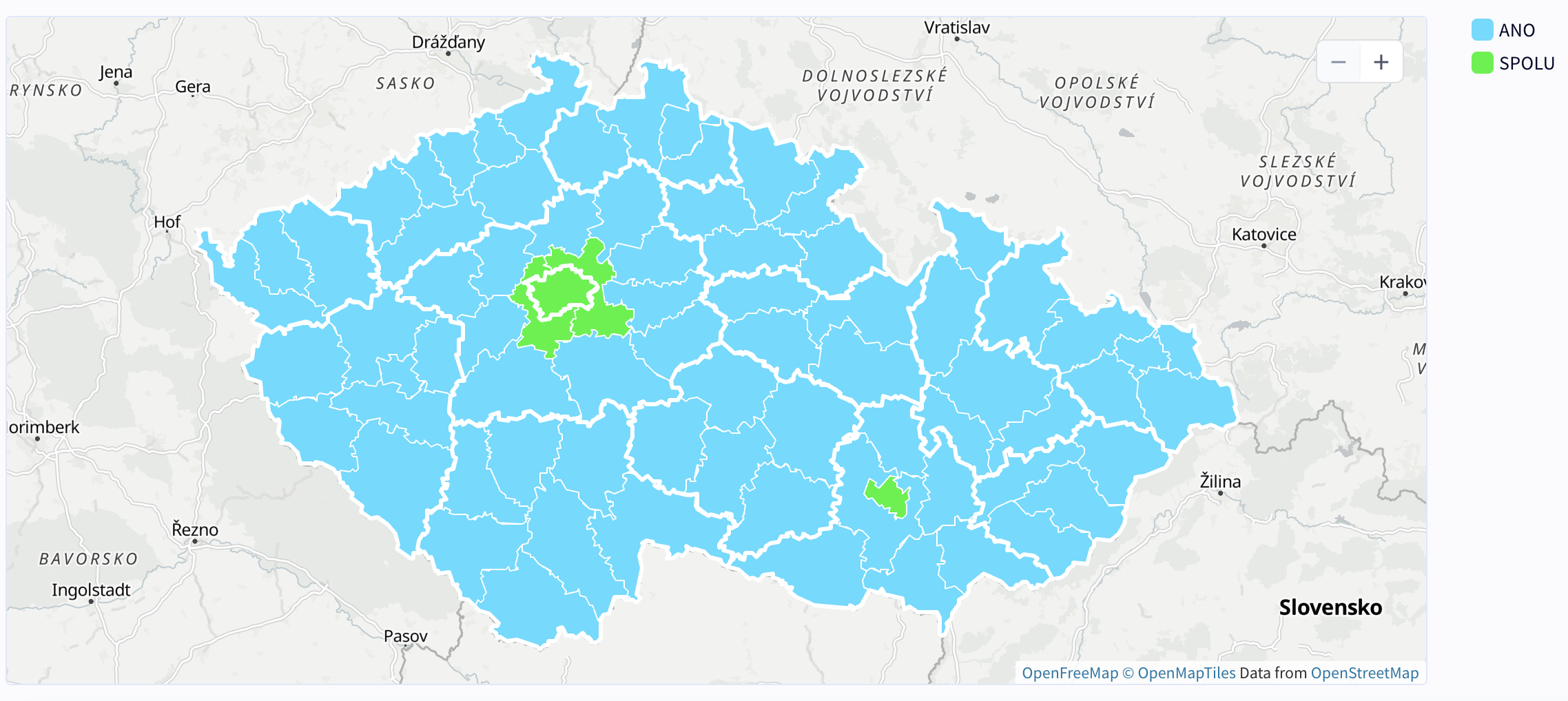Winning Party by District Map – 2025 Czech Parliamentary Elections


Alex Cartwright
Senior Cartographer & GIS Specialist
Alex Cartwright is a renowned cartographer and geographic information systems specialist with over 15 years of experience in spatial analysis and data...
Geographic Analysis
What This Map Shows
The "Winning Party by District – 2025 Czech Parliamentary Elections" map offers a detailed visualization of the political landscape across the Czech Republic following the most recent parliamentary elections. This geographical representation highlights which political party secured victory in each electoral district, allowing for a clear understanding of regional political preferences and affiliations. With distinct colors representing different parties, the map serves as an essential tool for analyzing the electoral outcome, showcasing the distribution of political power throughout the country.
Deep Dive into Political Landscape in the Czech Republic
The political landscape in the Czech Republic is diverse, reflecting a variety of ideologies and party platforms. The 2025 elections have seen significant shifts in voter sentiment, influenced by numerous factors such as economic performance, social issues, and international relations. Understanding these dynamics is crucial for grasping the electoral map's implications.
In recent years, parties like the Czech Pirate Party and the ODS (Civic Democratic Party) have made substantial gains, appealing to younger voters and those concerned with transparency and governance reform. Conversely, traditional parties like ČSSD (Czech Social Democratic Party) have faced challenges, often losing ground in urban districts where progressive policies resonate more strongly.
Interestingly, the map reveals stark contrasts between urban and rural areas. Urban districts, particularly in Prague and Brno, tend to favor more progressive parties, reflecting the demographic shifts and changing values within these cities. For example, the Pirate Party's dominance in Prague can be attributed to a young, liberal electorate that prioritizes issues such as digital rights and environmental sustainability.
On the other hand, rural districts often lean toward conservative parties, such as the ODS or the SPD (Freedom and Direct Democracy), which resonate with voters concerned about national identity, immigration, and traditional values. This polarization highlights the significant divide in political ideology and voter priorities across different regions.
Moreover, the role of regional parties cannot be overlooked. In areas with distinct cultural identities, local parties often play a significant role in shaping the political dialogue. The presence of these parties adds another layer of complexity to the electoral map, as they can sway results in tightly contested districts.
Regional Analysis
Examining the electoral outcomes by region reveals intriguing patterns. For instance, in the capital city, Prague, the Pirate Party's influence is evident, dominating numerous districts. The city's demographic profile, characterized by high levels of education and a youthful population, aligns with the party's platform, which emphasizes innovation and digital rights.
Conversely, in regions like Ústí nad Labem and Karlovy Vary, more conservative parties have a stronger foothold. Here, traditional values and local economic concerns resonate more strongly with voters, leading to a significant representation of the ODS and SPD. This juxtaposition illustrates the broader socio-economic factors at play, as these areas often grapple with higher unemployment rates and economic stagnation.
What's fascinating is how the map can serve as a predictive tool for future elections. Trends in voter behavior, as indicated by this map, suggest that parties focusing on environmental issues and digital transformation may continue to gain traction, especially in urban centers. However, conservative parties will likely maintain their influence in rural areas where economic stability and national identity are paramount.
Significance and Impact
Understanding the winning parties by district is not just about grasping the current political climate; it has profound implications for governance and policy-making in the Czech Republic. The distribution of political power, as illustrated by this map, impacts everything from local governance to national legislation.
For instance, districts leaning toward progressive parties may prioritize policies related to climate action, digital infrastructure, and social equality, while conservative districts may focus on issues like economic growth and immigration control. As such, the electoral map serves as a reflection of the broader societal values and challenges facing the Czech Republic today.
Looking ahead, analysts predict that the Czech political landscape may continue to evolve, influenced by changing demographics, economic conditions, and global events. The 2025 elections have laid the groundwork for future political debates, and the map serves as a crucial reference point for understanding these dynamics. Have you noticed how shifts in voter sentiment can redefine the political contours of a nation? The insights gained from this map will undoubtedly inform our understanding of the Czech Republic's political future and the potential for new alliances and conflicts.
Visualization Details
- Published
- October 4, 2025
- Views
- 52
Comments
Loading comments...